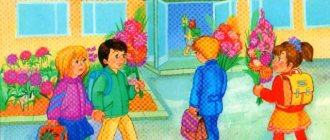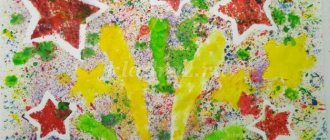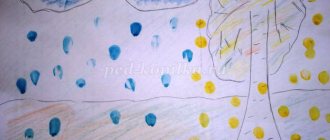Summary of a drawing lesson in the first junior group “The Bunny Came to Visit Us”
Goal: development of speech, memory, attention.
Program content:
- Improve the ability to examine objects: learn to examine, feel, stroke.
- Give an idea of the characteristics of an object (size, length), quantity (many, few).
- Continue learning to paint using the method of touching your fingers to a sheet of paper.
- Enrich passive vocabulary. Activate children's speech by encouraging them to repeat words after the teacher.
Demonstrative material : large toy hare, watercolor paint, a carrot-shaped box with candies.
Handout : blue watercolor paint, a sheet of paper with drawn silhouettes of a Christmas tree and a hare, napkins for each child.
Preliminary work . Working with methodological literature, writing notes. Examining the footprints of hares in illustrations with children.
Vocabulary work : tracks, hares, big, small, one, many.
Methodological examples . Surprise moment, artistic word. Review and explanation of drawing techniques. Dipping. Analysis.
Progress of the lesson
Educator . Today I’m going to kindergarten and I see: a bunny sitting under a snow-covered bush and crying. I felt sorry for him, I took him with me and brought him here, to my kids. Look how good he is. You probably feel sorry for him too. Show how sorry you are for the bunny.
Bunny . I'm a little bunny
That's how remote he is!
I'm not cold in winter
In a warm fur coat.
Educator . Touch the bunny's fur coat. His fur is fluffy, soft, and warm. Repeat, what kind of fur coat does the bunny have?
Children . Fluffy, soft, warm.
Educator _ Where is his head? Here's the head. It's round. Varya, let’s circle the bunny’s head with our hand. What kind of head does a bunny have?
Children . Round.
Educator . And what's that?
Children . Ears.
Educator . That's right, ears! Run your hand over your ear. It's long. Which ear?
Children . Long.
Educator . One ear, the other ear - two ears. Where are the bunny's eyes? Here they are. What funny eyes he has. Show me your nose. It's pink. Feel how smooth it is. And what's that?
Children . Mouth.
Educator . Look how white the bunny's teeth are. He deftly gnaws a carrot with his teeth. Now show the bunny's tummy and back. Pet them. Well done! The bunny really likes it. What else does the hare have?
Children . Tail.
Educator . That's right, ponytail. Small, white, fluffy. Where are the paws? Here are the paws. The hare has four legs. Children, how many legs does a hare have?
Children . Four.
Educator . That's right, well done! This is how merrily the bunny jumps. Let's play the game “The Little White Bunny Plays” together.
Children play under the guidance of a teacher.
Educator . Okay, well done. We frolicked. Now sit down on the chairs, and I’ll draw you how bunnies play happily in the forest, jumping and leaving footprints in the snow - under the Christmas tree. Look, I put my fingers into a fist, and I bend one finger and put paint on it. So I dip my finger in the paint (I show) and press it to a sheet of paper - you get a bunny trail. Jump-jump-jump-jump. Bunny in the snow: jump and jump.
Educator . Now sit down at your tables. Look who's hiding under the Christmas trees?
Children . Bunnies.
Educator . That's right, bunnies. Now we draw footprints in the snow under the Christmas tree on our sheets (children draw). Well done. What did you draw?
Children . Footprints.
Educator . Now let us also go and jump in the footsteps, like our bunnies. Jump-jump-jump-jump.
Children complete the task.
Educator . Oh, who's that hiding in the bushes? Is this a little bunny? Children, let us feel sorry for him.
Children stroke the hare's head.
Educator _ Tell me, who offended you? What's happened?
Bunny . How can I not cry? I got scared in the forest, I got lost in the forest. How can I find friends now? How will I get home?
Educator . Do not worry. You will follow the tracks in the forest and you will find your friends.
Bunny . Well, thanks, kids! They didn't leave me in trouble. I'll hurry home quickly. And for you I have a gift (gives a box in the shape of a carrot).
Educator . What did the bunny give you?
Children . Carrot.
Educator . Let's have a treat together with the bunnies.
Author: Valikova Valentina Ivanovna,
teacher of the first junior group
MADO kindergarten No. 69 “Rosinka”
urban district of Sterlitamak
Republic of Bashkortostan
The article is published in the author's edition
Project in the 1st junior group of the preschool educational institution “Instead of a brush, a hand.”
Project activity for the development of fine motor skills of children’s fingers in the first junior group “Instead of a brush, a hand.”
Project type:
creative.
Project implementation period:
medium term.
Project participants:
children of the first junior group, parents of pupils, teacher-defectologist of the group.
The goal of the project:
to develop artistic and creative abilities and fine motor skills of the fingers of young children through the use of non-traditional drawing techniques.
Project objectives:
- To introduce young children to non-traditional methods of drawing (with fingers, palms), to develop interest in visual arts; — To promote students’ mastery of the simplest non-traditional methods of drawing, to continue to familiarize children with the names of primary colors;
— Develop fine motor skills of the fingers. — To help parents familiarize themselves with non-traditional drawing techniques; We stimulate their joint creativity with children. Theme and its relevance:
I draw - my hands are covered in paint, this is a small thing for me, I paint with bright paint, look at me.
Early age is a period when the formation of all organs and systems of the body proceeds at a very rapid pace. Therefore, it is very important to lay the foundations for full development in a timely manner. Fine art brings a lot of joy to a little person; the need for drawing is inherent at the genetic level; by copying the world around them, they study it. Having experienced an interest in creativity, they themselves find the necessary ways. But not everyone succeeds in this, especially since many children are just beginning to master artistic activities. Children love to learn new things and study with pleasure. It is by learning, gaining knowledge and skills that a child feels confident. Drawing with unusual materials and original techniques allows children to experience unforgettable positive emotions. Unconventional drawing reveals new possibilities for using objects familiar to children as artistic materials and surprises with its unpredictability. Original drawing without a brush or pencil relaxes the child, allows him to feel the colors, their character, and mood. Unbeknownst to themselves, children learn to observe, think, and fantasize. Unusual materials and original techniques attract children because the word “No” is not present here, you can draw with whatever you want and how you want, and you can even come up with your own unusual technique. Children feel unforgettable, positive emotions, and by emotions one can judge the child’s mood, what makes him happy, what makes him sad.
Main stages of the project:
Stage I – Preparatory:
— selection and study of methodological literature, Internet resources on this topic;
— development of project content; - planning upcoming activities, - selecting visual demonstration material. Stage II - Practical: providing conditions for the implementation of the project:
- development of games and activities for students; — educating parents on the use of non-traditional drawing techniques; — development and accumulation of methodological materials, developments, recommendations on the topic “Non-traditional drawing techniques with young children.”
I present a list of games and activities in non-traditional ways conducted with children as part of the project.
Topic: “On the way to kindergarten”, drawing with a cotton swab (autumn tree, leaves).
Target:
teach children to draw dots with their fingers, continue to introduce primary colors (yellow, green), develop fine motor skills, and cultivate children’s interest in visual arts. Topic: “Group tour”, finger drawing “Smile for an emoticon”.
Target:
teach children to draw with their fingers, draw an arc, develop fine motor skills, and cultivate children's interest in visual arts.
Topic: “Horses in the meadow”, group work, finger painting. Goal:
teach children to draw with their fingers, improve the child’s fine motor skills.
Develop fantasy and imagination, support the emotional mood of children. Topic: “Let’s feed the birds,” drawing with a cotton swab “Grains for the birds.” Goal:
teach children to draw with cotton swabs.
Develop fantasy and imagination, support the emotional mood of children. Topic: “A snowball is falling quietly”, drawing with a cotton swab (traces of falling snow flakes). Goal:
learn to draw with cotton swabs, rhythmically make an imprint on paper;
perform movements in accordance with the rhythm of the music. Topic: “Elegant Christmas tree”, finger painting, group work. Goal:
to strengthen children’s ability to dip their finger into gouache and leave a mark on a sheet of paper with an image prepared in advance, to cultivate a sense of beauty.
Stage III - Final (analytical):
— design of an exhibition of drawings; — identifying children’s skills in using non-traditional drawing materials in their work; — participation of children in All-Russian competitions.
Forms of work, methods and techniques.
Working with parents:
- conversations with parents;
— consultations for parents; — designing a corner for parents on this topic; — exhibition (collective works of children); - joint creative activity. Working with children:
- joint activities of an adult and a child;
- looking at illustrations; - reading fiction; - productive activities accompanied by music, - games and exercises accompanied by the texts of poems; - observation of nature; - looking at toys; - exhibition design. Methods of unconventional drawing. “Finger painting”:
the child dips his finger in the gouache and puts dots and specks on the paper.
Each finger is painted with a different color. After work, wipe your fingers with a napkin, then the gouache is easily washed off. “Dot Drawing”:
One of the unusual techniques is dot painting. Regular cotton swabs are suitable for this. The principle is very simple: you need to dip a stick in paint and leave a mark on a sheet of paper. It could be rain, snow or grains for chickens, chickens, mice.
Expected results of the project:
— formation in children of the early age group of knowledge about non-traditional methods of drawing (drawing with fingers and palms); - development in children of skills and abilities to use a variety of visual media; — increasing the competence of parents of pupils in the issue of drawing using non-traditional techniques, active participation of parents in joint creative projects.
Conclusion:
The “Hand Instead of a Brush” project (non-traditional drawing methods for kids) is aimed at developing creative imagination in young children through the use of non-traditional drawing techniques. An unconventional approach to creating images gives impetus to the development of children's intellect, encourages the child's creative activity, and teaches him to think outside the box. An important condition for a child’s development is an original task, the very formulation of which becomes a stimulus for creativity. Children are very attracted to non-traditional materials; the more diverse the art materials, the more interesting it is to work with them. Therefore, introducing preschoolers to non-traditional drawing techniques allows not only to increase children’s interest in visual arts, but also contributes to the development of creative imagination. Using non-traditional drawing methods, I came to the conclusion: if you like it when your children’s eyes sparkle with delight during class, if you want every lesson to be a holiday, if you want to laugh, be surprised and communicate with smart, creatively thinking children, you need observe, draw and improvise more with them. I intend to continue to work in this direction, since non-traditional drawing techniques open up opportunities for children to develop creative abilities, fantasy, and imagination.
Bibliography:
1. G. N. Davydova “Non-traditional drawing techniques”, 2. M: Scriptorium 2003. 3. A. V. Nikitina “Non-traditional drawing techniques”, KARO, 2010. 4. N. V. Nishcheva “Grow up, baby!” , “Childhood-Press”, 2022. 5. O. E. Litvinova “Artistic and aesthetic development of a child of early preschool age (visual activity)”, developed in accordance with the Federal State Educational Standard, CHILDHOOD-PRESS, 2014. 6. I. A. Lykova Program of artistic education, training and development of children 2-7 years old “Colored palms”, M.: “KARAPUZ-DIDACTICS”, 2014. 7. Lebedeva E.N. The use of non-traditional techniques [Electronic resource]







